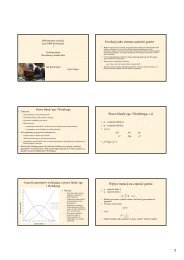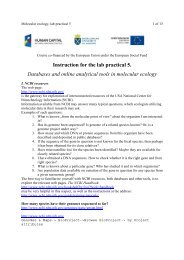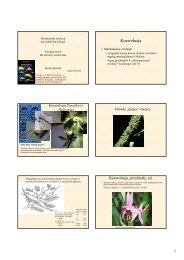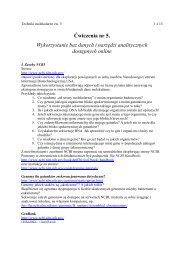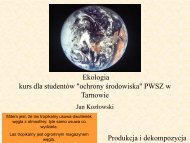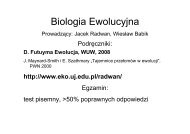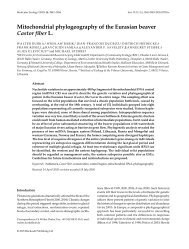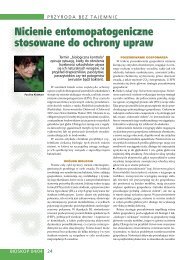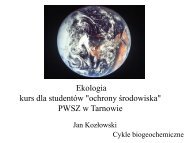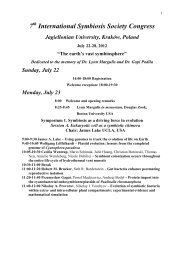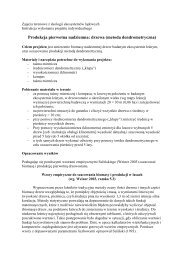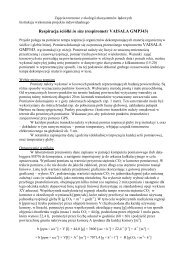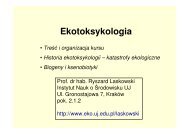Strong association between a single gene and fertilization efficiency ...
Strong association between a single gene and fertilization efficiency ...
Strong association between a single gene and fertilization efficiency ...
Create successful ePaper yourself
Turn your PDF publications into a flip-book with our unique Google optimized e-Paper software.
<strong>Strong</strong> <strong>association</strong> <strong>between</strong> a <strong>single</strong> <strong>gene</strong><br />
<strong>and</strong> <strong>fertilization</strong> <strong>efficiency</strong> of males <strong>and</strong> fecundity<br />
of their mates in the bulb mite<br />
Magdalena Konior 1,2 , Jacek Radwan 1, *, Maria Kołodziejczyk 1<br />
<strong>and</strong> Laurent Keller 2<br />
Proc. R. Soc. B (2006) 273, 309–314<br />
doi:10.1098/rspb.2005.3302<br />
Published online 8 November 2005<br />
1 Institute of Environmental Sciences, Jagiellonian University, ul. Gronostajowa 7, 30-387 Kracow, Pol<strong>and</strong><br />
2 Department of Ecology <strong>and</strong> Evolution, BB, University of Lausanne, 1015 Lausanne, Switzerl<strong>and</strong><br />
Although variation in male <strong>fertilization</strong> <strong>efficiency</strong> has been shown to have a <strong>gene</strong>tic basis in several species,<br />
the <strong>gene</strong>s responsible for the effect are <strong>gene</strong>rally unknown. Here, we show a strong <strong>association</strong> <strong>between</strong> the<br />
<strong>fertilization</strong> success of males <strong>and</strong> their phosphogluconate dehydrogenase (Pgdh) genotype in the bulb mite<br />
Rhizoglyphus robini. Males homozygous for the slow (S) allele fathered a significantly greater proportion of<br />
offspring when competing with males homozygous for the fast (F) allele. There was no evidence that<br />
female fecundity was influenced by their Pgdh genotype. The fecundity of FF females did not differ<br />
significantly from the fecundity of SS females but female fecundity was significantly influenced by the<br />
genotype of their mate. Females paired with SS males laid significantly fewer eggs than females paired with<br />
FF males. Altogether these data show a trade-off, with the male SS genotype associated with their higher<br />
<strong>fertilization</strong> <strong>efficiency</strong> but at the cost of a negative impact on the fecundity of females mating with them.<br />
Keywords: sexual selection; sperm competition; inter-sexual conflict; enzyme polymorphism<br />
1. INTRODUCTION<br />
Because the females of many sexually reproducing<br />
organisms mate with several males (Birkhead & Møller<br />
1998), the reproductive success of males is commonly<br />
influenced by processes occurring after insemination has<br />
taken place. Variation in <strong>fertilization</strong> <strong>efficiency</strong> <strong>between</strong><br />
males can result from the difference in one or several of the<br />
four following characteristics (Keller & Reeve 1995): (i)<br />
the quantity of sperm they produce, (ii) the success of their<br />
sperm in reaching <strong>and</strong> fertilizing an egg, (iii) their ability to<br />
displace the sperm that females stored during previous<br />
matings <strong>and</strong> (iv) their ability to prevent any other male<br />
from subsequently introducing sperm (e.g. differential<br />
<strong>efficiency</strong> of mating plugs).<br />
Experimental studies have revealed consistent differences<br />
among males in <strong>fertilization</strong> <strong>efficiency</strong> (Lewis &<br />
Austad 1990; Cordero & Miller 1992; Radwan 1996) <strong>and</strong><br />
there is increasing evidence that this variation has an<br />
important <strong>gene</strong>tic component. For example, in various<br />
species males of different strains exhibit variation in<br />
<strong>fertilization</strong> success (Napier 1961; Wooley & Beatty<br />
1967; Krzanowska et al. 1991; Kirby & Froman 1991).<br />
Many phenotypic traits presumably influencing <strong>fertilization</strong><br />
<strong>efficiency</strong> have also been shown to have additive<br />
<strong>gene</strong>tic variance <strong>and</strong> exhibit a significant heritability<br />
(reviews in Keller & Reeve 1995; Pizzari & Birkhead<br />
2002), <strong>and</strong> the heritability of male sperm competition<br />
success has been demonstrated (Radwan 1998; Konior<br />
et al. in press). Finally, selection experiments have revealed<br />
that the <strong>fertilization</strong> <strong>efficiency</strong> of males is increased in<br />
selection lines where females mate with several males<br />
* Author for correspondence (radwan@eko.uj.edu.pl).<br />
compared to monogamous lines (Bernasconi & Keller<br />
2001; Hosken et al. 2001; Pitnick et al. 2001), implying its<br />
heritability.<br />
Although the <strong>fertilization</strong> <strong>efficiency</strong> of males has been<br />
shown to have a strong <strong>gene</strong>tic basis in many species, the<br />
<strong>gene</strong>s responsible for the effect have been identified in only<br />
a couple of instances. In Drosophila melanogaster particular<br />
alleles at four accessory gl<strong>and</strong> protein (Acp) <strong>gene</strong>s were<br />
significantly associated with males’ ability to resist spermdisplacement<br />
by sperm from males that subsequently<br />
mated with the same females (Clark et al. 1995). By<br />
contrast, no clear <strong>association</strong> was found <strong>between</strong> the<br />
genotype at Acp <strong>and</strong> males’ ability to displace sperm that<br />
females stored during previous matings (Clark et al. 1995).<br />
In the yellow dung fly Scatophaga stercoraria, the male<br />
genotype at the Pgm locus was found to interact with the<br />
female genotype <strong>and</strong> the environment in which she<br />
oviposited, in affecting male paternity (Ward 2000). This<br />
effect was attributed to cryptic female choice evolved to<br />
produce optimal progeny genotypes in a given environment<br />
(Ward 2000).<br />
Here, we investigated the <strong>association</strong> <strong>between</strong> the<br />
enzyme-encoding <strong>gene</strong> phosphogluconate dehydrogenase<br />
(Pgdh) genotype <strong>and</strong> male <strong>fertilization</strong> <strong>efficiency</strong> in the<br />
bulb mite Rhizoglyphus robini. The study was prompted by<br />
the reanalysis of data obtained by Kołodziejczyk et al.<br />
(2002) in a survey of enzyme polymorphisms in mites of<br />
the genus Rhizoglyphus. The reanalysis (reported below)<br />
indicated that a male’s genotype may be associated with<br />
his sperm competition success. This result was confirmed<br />
in a new set of experiments where we mated females with<br />
males of different Pgdh genotypes. We also conducted<br />
experiments to determine whether a female’s genotype at<br />
Pgdh was associated with differences in fecundity. Finally,<br />
Received 25 July 2005<br />
Accepted 25 August 2005<br />
309 q 2005 The Royal Society
310 M. Konior <strong>and</strong> others PGDH <strong>and</strong> sperm competition<br />
we tested whether the fecundity of females was influenced<br />
by the genotype of males. These experiments were<br />
prompted by previous studies indicating the presence of<br />
sexually antagonistic <strong>gene</strong>s having a positive effect on male<br />
reproductive success while decreasing the fitness of<br />
females mating with males harbouring such <strong>gene</strong>s (Rice<br />
1996; Friberg & Arnqvist, 2003).<br />
2. MATERIAL AND METHODS<br />
(a) PGDH allozymes<br />
The fast (F) <strong>and</strong> slow (S) phosphogluconate dehydrogenase<br />
(PGDH, EC 1.1.1.44) electromorphs were separated by<br />
cellulose acetate electrophoresis. Cellulose acetate plates<br />
(Malta Chemetron, Milano, Italy) were soaked for 20 min<br />
in 10% TME 7.4 (0.1 M Tris, 0.1 M maleic acid, 0.01 M<br />
diosodium EDTA, 0.01 M MgCl 2 $6H 2 O, adjusted to pH 7<br />
with KOH). Before samples were applied, the plates were<br />
gently dried on filter paper. Individual mites were homogenized<br />
in 3 ml of distilled water containing NADP<br />
(5 mg/100 ml) <strong>and</strong> immediately transferred onto the plate.<br />
The plate was loaded with seven samples, <strong>and</strong> the eighth lane<br />
contained a mixture of FF <strong>and</strong> SS homozygotes from preselected<br />
sub-populations (see below) <strong>and</strong> served as a<br />
reference. The plate was placed in a horizontal tank <strong>and</strong><br />
run in 10% TME 7.4 buffer at 170–250 V, ca 4 mA for<br />
20–30 min at room temperature. Plates were stained with<br />
5 ml 0.2 M Tris HCl pH 8.90, 0.1 ml MgCl 2 , 10 mg<br />
6-phosphogluconic acid, 0.1 ml NADP, 0.1 ml PMS <strong>and</strong><br />
0.1 ml MTT.<br />
(b) Re-analysis of previous data<br />
As a part of a survey of enzymatic polymorphism in the genus<br />
Rhizoglyphus. Kołodziejczyk et al. (2002) conducted a<br />
preliminary study to determine whether Pgdh could be used<br />
as a marker of paternity in R. robini (Kołodziejczyk et al.<br />
2002). In that study females from a population made<br />
homozygous for the S allele were mated with two males<br />
r<strong>and</strong>omly selected from a stock population. The males were<br />
then genotyped, <strong>and</strong> paternity was analysed for the doublematings<br />
that involved males homozygous for the two<br />
alternative alleles (i.e. five double-matings in which a female<br />
mated first with a SS male <strong>and</strong> 14 matings where the female<br />
mated first with a FF male, see Kołodziejczyk et al. 2002 for<br />
further details), but the test comparing P 2 (proportion of eggs<br />
fertilized by the second male) <strong>between</strong> these two mating<br />
orders was not reported. Here, we present a reanalysis of that<br />
data in which we compare <strong>fertilization</strong> success of males<br />
homozygous for alternative Pgdh alleles.<br />
(c) The mites<br />
The mites came from a founding population of about 100<br />
mites obtained from onions collected in 2001 near Krakówin<br />
Pol<strong>and</strong> <strong>and</strong>, after population expansion, maintained as a large<br />
stock culture (further referred to as 2001 stock culture)<br />
containing over 500 individuals. The mites were maintained<br />
in desiccators at room temperature <strong>and</strong> O90% relative<br />
humidity. Individuals were fed ad libitum with a 3 : 1 mixture<br />
of powdered yeast <strong>and</strong> wheat germ. Three weeks after the<br />
mites were brought to the laboratory, i.e. when the first labreared<br />
<strong>gene</strong>ration achieved maturity, a sample of 42 females<br />
was genotyped to determine whether the population was<br />
polymorphic at Pgdh (we used females because they are larger<br />
<strong>and</strong> easier to genotype). Another 40 females were genotyped<br />
in 2004 to determine whether the frequency of the two Pgdh<br />
alleles had changed after 3 years of laboratory rearing (i.e.<br />
after about 60 <strong>gene</strong>rations).<br />
(d) Homozygous sub-populations<br />
After two months of laboratory rearing we established two<br />
sub-populations homozygous for Pgdh (i.e. the SS <strong>and</strong> FF<br />
sub-populations). The SS sub-population was established<br />
by mixing the progeny of 20 pairs of parents homozygous<br />
for the S allele (4 offspring per pair). Both parents were<br />
genotyped after they produced progeny. Because the F<br />
allele is uncommon it was not possible to use the same<br />
procedure to establish an FF population in a <strong>single</strong><br />
<strong>gene</strong>ration. The FF sub-population was established over<br />
two <strong>gene</strong>rations. In the first <strong>gene</strong>ration, we mated females<br />
with one male <strong>and</strong> selected 4–8 offspring in families where<br />
each parent had at least one copy of the F allele (parents<br />
were genotyped after offspring were produced). In the next<br />
<strong>gene</strong>ration we coupled these families at r<strong>and</strong>om <strong>and</strong> for<br />
each couple we paired males from one family with females<br />
from another family <strong>and</strong> vice versa (i.e. 4–8 pairs per couple<br />
of families). Subsequent genotyping of these pairs revealed<br />
13 couples of families containing at least one pair of mates<br />
both homozygous for the F allele. These 13 pairs of<br />
individuals were unrelated within pairs <strong>and</strong> across pairs,<br />
<strong>and</strong> we used 4 offspring from each pair to establish the FF<br />
sub-population.<br />
The sub-populations were then allowed to exp<strong>and</strong> for<br />
about three months. During that time, each sub-population<br />
was maintained in a 2.5 cm diameter tube under identical<br />
regimes. All the experiments described below were completed<br />
within six months after the end of the expansion period.<br />
Before conducting the sperm competition <strong>and</strong> male harmfulness<br />
experiments we isolated larvae in 0.8 cm diameter glass<br />
tubes (2 cm high) with Plaster of Paris bases soaked with<br />
water. All these tubes were placed in the same desiccator<br />
throughout larval development (about 6 days). After adult<br />
males emerged, they remained in the same tubes <strong>and</strong> were<br />
supplied with a female from the stock population. They<br />
remained paired for 2 days before being used for experiments.<br />
This was done to mimic the natural situation of this colonial<br />
species where males have constant access to females.<br />
Additionally, this helped to st<strong>and</strong>ardize reserves of semen<br />
<strong>between</strong> males (Radwan 1997).<br />
(e) Sperm competition<br />
12 FF <strong>and</strong> 12 SS virgin females were sequentially presented<br />
with two males. Each male was paired for 2 h with the<br />
female. This time was sufficient for the majority of pairs to<br />
mate (in a similar setting, (Radwan et al. 2005) recorded<br />
about 90% pairs initiating copulation within 90 min,<br />
nZ60), but not long enough for repeated matings to<br />
occur. In half of the experiments the female was presented<br />
first with a FF male then with a SS male while in the other<br />
half male order was reversed. After mating the females were<br />
allowed to lay eggs for 5 days, after which both parents were<br />
genotyped to confirm that they were both homozygous for<br />
the F or S alleles. After progeny matured, 20 individuals<br />
were r<strong>and</strong>omly selected from each family to be genotyped<br />
at Pgdh.<br />
(f) Female genotype <strong>and</strong> fecundity<br />
To determine whether the <strong>gene</strong>tic correlation <strong>between</strong> sperm<br />
competitiveness <strong>and</strong> fecundity uncovered in previous studies<br />
Proc. R. Soc. B (2006)
PGDH <strong>and</strong> sperm competition M. Konior <strong>and</strong> others 311<br />
(Konior et al. 2001; Kozielska et al. 2004) was associated with<br />
the Pgdh locus, we paired 46 virgin SS females <strong>and</strong> 59 virgin<br />
FF females with males from the 2001 stock culture. The male<br />
was exchanged every day for the first 3 days, such that each<br />
female mated with three males. Three males were used to<br />
reduce the effects of occasional male infertility on female<br />
fecundity. On the fifth day, all eggs laid by each female were<br />
counted.<br />
(g) Male harmfulness<br />
To determine whether there was an <strong>association</strong> <strong>between</strong> male<br />
Pgdh genotype <strong>and</strong> the fecundity of their mates, virgin females<br />
from stock cultures were paired during 10 days with one SS<br />
(nZ81) or FF (nZ77) males. Males were replaced every<br />
2 days with another male of the same genotype, so that each<br />
female was paired with five males in turns. Two days after the<br />
last male was removed, we counted the eggs laid by each<br />
female.<br />
3. RESULTS<br />
(a) Re-analysis of previous data<br />
The proportion of offspring fathered by the two males<br />
mating with the same female was influenced by their<br />
genotype. The proportion of offspring fathered by SS<br />
males that mated with a female previously mated with an<br />
FF male was 0.79G0.25 (meanGs.d., nZ14) while this<br />
proportion was 0.33G0.41 (nZ5) for FF males that<br />
mated with a female previously mated with an SS male.<br />
The difference in <strong>fertilization</strong> <strong>efficiency</strong> <strong>between</strong> the<br />
genotypes was significant (Mann–Whitney UZ13,<br />
PZ0.042).<br />
(b) New data<br />
The proportion of offspring fathered by the two males<br />
mating with the same female was also significantly<br />
influenced by their genotype, with SS males achieving a<br />
greater paternity than FF males (figure 1, F 1,20 Z8.72,<br />
pZ0.007). By contrast, the female genotype did not<br />
significantly affect the relative paternity of males of the two<br />
alternative Pgdh genotypes (F 1,20 Z0.61, pZ0.44). The<br />
interaction <strong>between</strong> male <strong>and</strong> female genotype was also<br />
not significant (F 1,20 Z2.95, pZ0.10).<br />
There was no evidence that female fecundity was<br />
influenced by their Pgdh genotype. The fecundity of FF<br />
females (meanGs.d.Z129.6G64.9) was not significantly<br />
different (F 1,103 Z12.37, pZ0.13) from the fecundity of<br />
SS females (meanGs.d.Z109.6G67.8). By contrast, the<br />
fecundity of females was influenced by the genotype of<br />
their mate. Females paired with a SS male laid 60.7G52.8<br />
eggs, whereas females paired with a FF male laid 82.0G<br />
42.6 eggs (F 1,156 Z7.76, pZ0.006). Thus, males with the<br />
genotype associated with higher <strong>fertilization</strong> <strong>efficiency</strong> had<br />
a negative impact on the fecundity of their partners<br />
compared to males with the genotype associated with<br />
lowest <strong>fertilization</strong> <strong>efficiency</strong>.<br />
The frequency of genotypes at the locus Pgdh changed<br />
significantly in the stock population over the 3 years of<br />
laboratory rearing. While the frequency of heterozygotes<br />
was 22% in 2001 (i.e. shortly after the population was<br />
brought to the laboratory; nZ42 females, nine heterozygotes<br />
<strong>and</strong> 33 SS homozygotes), all females (nZ40)<br />
genotyped in 2004 were homozygous for the S allele<br />
(Fisher exact: pZ0.003).<br />
proportion of eggs<br />
fertilised by the 2nd male<br />
1.0<br />
0.8<br />
0.6<br />
0.4<br />
0.2<br />
0<br />
female FF<br />
female SS<br />
Figure 1. Proportion of eggs fertilized by the second male<br />
mating with the female; filled bars, SS males; open bars, FF<br />
males; error bars, st<strong>and</strong>ard deviation.<br />
4. DISCUSSION<br />
The results of our controlled mating experiments revealed<br />
a strong <strong>association</strong> <strong>between</strong> the <strong>fertilization</strong> success of<br />
males <strong>and</strong> their Pgdh genotype. Bulb mite males with the<br />
SS genotype at Pgdh fathered a significantly greater<br />
proportion of offspring than competing FF homozygote<br />
males. Two lines of evidence support the view that this<br />
difference in <strong>fertilization</strong> <strong>efficiency</strong> cannot be explained by<br />
a possible difference in inbreeding <strong>between</strong> the FF <strong>and</strong> SS<br />
sub-populations. First, <strong>and</strong> most importantly, the<br />
inbreeding associated with the founding of the two subpopulations<br />
was determined by their initial effective<br />
population size of 52 (2N individuals, as each of the<br />
founding pair contributed the same number of progeny)<br />
for the FF sub-population <strong>and</strong> 80 for the SS subpopulations.<br />
Since the sub-populations quickly exp<strong>and</strong>ed,<br />
the possible difference in inbreeding was mostly due to this<br />
initial bottleneck event, with a DF (an increase in<br />
inbreeding coefficient) of 1/52Z0.02 for the FF subpopulation<br />
<strong>and</strong> 1/80Z0.012 SS subpopulation. Such a<br />
relatively low level of inbreeding is unlikely to significantly<br />
affect <strong>fertilization</strong> <strong>efficiency</strong> of males. Konior et al. (2005)<br />
reported a 53% decline in <strong>fertilization</strong> success after full-sib<br />
mating (FZ0.25). Assuming that the decrease in <strong>fertilization</strong><br />
<strong>efficiency</strong> is linearly associated with the level of<br />
inbreeding, the difference in inbreeding <strong>between</strong> the FF<br />
<strong>and</strong> SS sub-populations could account for roughly a 1.6%<br />
((0.02K0.012)!212%) of the difference in <strong>fertilization</strong><br />
<strong>efficiency</strong>. This value is an order of magnitude lower than<br />
the observed effect (i.e. 34% for matings with FF females,<br />
<strong>and</strong> 71% for matings with SS females).<br />
The second piece of evidence that differences at the<br />
Pgdh locus are associated with differences in <strong>fertilization</strong><br />
<strong>efficiency</strong> comes from our re-analysis of the data reported<br />
by Kołodziejczyk et al. (2002). In that study differences in<br />
<strong>fertilization</strong> <strong>efficiency</strong> <strong>between</strong> males of alternative genotype<br />
could not stem from differences in inbreeding<br />
because all males came from the same population, yet<br />
SS males had a ca 58% higher <strong>fertilization</strong> <strong>efficiency</strong> than<br />
FF males. Thus the competitive advantage of SS males<br />
was about the same in the two independent experiments<br />
reported here.<br />
A potential caveat of our experiments is that difference<br />
in male reproductive success was measured at the adult,<br />
not egg, stage, making possible that genotypic differences<br />
in egg to adult survival could account for the different<br />
reproductive success of males. However, in another<br />
Proc. R. Soc. B (2006)
312 M. Konior <strong>and</strong> others PGDH <strong>and</strong> sperm competition<br />
experiment where sperm competitiveness was measured at<br />
the egg stage using sterile male technique (e.g. Radwan &<br />
Siva-Jothy 1996), SS males were also found to have higher<br />
<strong>fertilization</strong> <strong>efficiency</strong> (P. Łukasik, M. Zygadlo & J.<br />
Radwan 2004, unpublished work).<br />
The <strong>gene</strong> responsible for differences in male <strong>fertilization</strong><br />
<strong>efficiency</strong> may be the Pgdh itself, or one or more <strong>gene</strong>s<br />
in a very strong gametic disequilibrium with the Pgdh<br />
locus. The PGDH enzyme is involved in the pentose<br />
phosphate pathway of the oxidation of carbohydrates<br />
(Murray et al. 2003). Alternative Pgdh genotypes have<br />
<strong>gene</strong>ral effects on metabolic activity (Cavener & Clegg<br />
1981), with possible pleiotropic effect on a number of<br />
traits. This pathway also produces ribulose 5-phosphate,<br />
which is used for nucleotide biosynthesis. Thus, by<br />
controlling the rate of nucleic acid synthesis, the form of<br />
PGDH enzyme conceivably might affect the rate of cell<br />
division <strong>and</strong> spermato<strong>gene</strong>sis. That PGDH variants may<br />
indeed affect the phenotype is supported by several studies<br />
in plants <strong>and</strong> animals that reported an <strong>association</strong> <strong>between</strong><br />
the Pgdh genotype <strong>and</strong> components of fitness such as the<br />
probability of survival <strong>and</strong> salinity resistance in the wild<br />
(Stockwell & Mulvey 1998; Conte et al. 2003). Similarly,<br />
differences in the expression of a number of metabolic<br />
enzymes have recently been shown to affect male<br />
competitive reproductive success in D. melanogaster<br />
(Drnevich et al. 2004). It would thus be of interest to<br />
investigate whether males with alternative Pgdh genotypes<br />
differ in weight, testis weight or sperm morphology.<br />
The finding that males with the SS Pgdh genotype have<br />
higher <strong>fertilization</strong> <strong>efficiency</strong> raises the question of the<br />
selective forces maintaining a polymorphism at this locus<br />
(or the linked loci responsible for the difference in<br />
<strong>fertilization</strong> <strong>efficiency</strong>). Under natural condition, the<br />
frequency of the F allele is not rare (0.11 in the population<br />
used in this study <strong>and</strong> 0.32 in a population collected from<br />
the same location in 2003 (P. Łukasik, M. Zygadlo & J.<br />
Radwan 2004, unpublished work). There are several<br />
possible mechanisms that may counteract the disadvantage<br />
of FF males during the process of sperm competition.<br />
One such mechanism is male–female genotype-specific<br />
interaction as has been observed in D. melanogaster where<br />
the success of a particular male’s sperm is dependent on<br />
the genotype of the female with which he mates (Clark<br />
et al. 1999). The results of our experiments where females<br />
of alternative Pgdh genotype were mated with either FF or<br />
SS males failed to reveal a significant interaction <strong>between</strong><br />
male <strong>and</strong> female genotypes. However, our sample size was<br />
small <strong>and</strong> the power of the test low, precluding a strong<br />
conclusion.<br />
Another possibility is a pleiotropic effect associated<br />
with the Pgdh genotype. Kozielska et al. (2004) reported a<br />
positive correlation <strong>between</strong> bulb mite males’ <strong>fertilization</strong><br />
<strong>efficiency</strong> <strong>and</strong> fecundity of their daughters. If this effect<br />
was mediated by Pgdh or a linked <strong>gene</strong>, SS females should<br />
have a higher fecundity than FF females. However, our<br />
data do not support the hypothesis of a direct effect of<br />
Pgdh on female fecundity. The fecundities of FF females<br />
did not differ significantly from the fecundities of SS<br />
females. Importantly, however, the fecundity of females<br />
was influenced by the genotype of their mate, with females<br />
mated to SS males having a lower fecundity. This<br />
demonstrates the occurrence of a sexual conflict (Parker<br />
1979; Holl<strong>and</strong> & Rice 1998; Gavrilets et al. 2001) with the<br />
SS genotype conferring a positive effect on <strong>fertilization</strong><br />
<strong>efficiency</strong> of males but a negative effect on females that<br />
mated with males having such a genotype. These findings<br />
may provide an explanation for the observation that<br />
females with experimentally reduced access to males have<br />
higher fecundity than females constantly exposed to males<br />
(Kołodziejczyk & Radwan 2003).<br />
Finally, a third possibility is that females prefer to mate<br />
with males with the less harmful genotypes as has been<br />
observed in the cockroach Nauphoeta cinerea (Moore et al.<br />
2003). If females consistently discriminate against SS<br />
males, this may be a potent selective force maintaining the<br />
F allele in the wild. This possibility remains to be<br />
investigated. However, the loss of the F allele we observed<br />
in our stock culture hints against this mechanism.<br />
We found that the number of eggs laid by females in the<br />
experiment testing the effect of female genotype on their<br />
fecundity was considerably higher (109–129 eggs) than in<br />
the experiment testing male harmfulness (60–82 eggs).<br />
This difference most likely reflected a difference in rearing<br />
conditions of females <strong>between</strong> the two experiments rather<br />
than a difference of the longer exposure of females to males<br />
in the later experiment (10 days) compared to the former<br />
(3 days). Females used for the test of male harmfulness<br />
came from stock culture were mites were kept at higher<br />
density than was the case for females used in the<br />
experiment testing the effect of female genotype on their<br />
fecundity. Since, female fecundity in R. robini is very<br />
sensitive to even small environmental changes (e.g. Konior<br />
et al. 2001), it is likely that the fecundity differences<br />
stemmed from the difference in rearing conditions.<br />
Our study is consistent with the prediction of models of<br />
antagonistic coevolution that males achieving highest<br />
reproductive success (due to their ability to manipulate<br />
female preferences, behaviour or physiology) should<br />
impose the most detrimental effects on females (Holl<strong>and</strong><br />
& Rice 1998). Similarly, experimental manipulation of the<br />
intensity of sexual selection in three fly species resulted in<br />
an increase of the harmful effect of males on females in<br />
lines selected for higher <strong>fertilization</strong> <strong>efficiency</strong> (Holl<strong>and</strong> &<br />
Rice 1999; Hosken et al. 2001; Martin & Hosken 2004). In<br />
unselected populations, evidence that males achieving<br />
highest reproductive success impose more detrimental<br />
effects on females has been supported in a few other<br />
species. In the bluehead wrasse (Thalassoma bifasciatum),<br />
females mating with the males having the highest mating<br />
success have a lower proportion of their eggs fertilized<br />
because successful males transfer fewer sperm (Warner<br />
et al. 1995). In the cockroach N. cinerea males able to<br />
pheromonally manipulate females to decrease their<br />
remating rate, also negatively affect lifespan of their mating<br />
partners (Moore et al. 2003). In D. melanogaster larger male<br />
size is under positive sexual selection but is associated with<br />
an accelerated rate of ageing <strong>and</strong> reduced female lifespan<br />
(Pitnick & Garcia-Gonzalez 2002; Friberg & Arnqvist<br />
2003). Finally, in D. grimshawi, males exhibiting higher<br />
courtship vigour have a higher probability of mating, but<br />
they also have a negative effect on female fecundity<br />
(Droney 2003). Since mating in D. melanogaster incurs<br />
costs to females (Chapman et al. 1995) <strong>and</strong> because larger<br />
males mate more often, lower fitness of females paired to<br />
larger males might stem from increased mating frequency<br />
(Friberg & Arnqvist 2003). Whether bulb mite males<br />
homozygous for the S Pgdh allele mate more often, or if<br />
Proc. R. Soc. B (2006)
PGDH <strong>and</strong> sperm competition M. Konior <strong>and</strong> others 313<br />
they influence female fecundity by other means remains to<br />
be investigated.<br />
In conclusion, our study reveals that a <strong>single</strong> <strong>gene</strong>tic<br />
element, Pgdh itself, or one or more <strong>gene</strong>s in very strong<br />
gametic disequilibrium with the locus Pgdh, influence(s)<br />
both the <strong>fertilization</strong> <strong>efficiency</strong> of males <strong>and</strong> the fecundity<br />
of females mated with males of alternative genotypes.<br />
Importantly, while the Pgdh SS genotype confers a greater<br />
<strong>fertilization</strong> <strong>efficiency</strong> to males it also reduces the<br />
fecundity of females that mated with such males. Thus,<br />
the positive selection acting on SS males in the process of<br />
sperm competition is partly opposed by the selection<br />
arising through the decreased fecundity of their mates.<br />
The balance <strong>between</strong> the magnitude of these two selection<br />
forces will depend on the level of promiscuity. Because the<br />
level of promiscuity <strong>and</strong> sperm competition is probably<br />
higher under our laboratory conditions than in the wild<br />
(Radwan & Siva-Jothy 1996) this may lead to a relative<br />
increase of the selective effect through sperm competition<br />
<strong>and</strong> a disruption of the conditions allowing polymorphism<br />
to be maintained at Pgdh. Consistent with this prediction<br />
we observed a significant decline in the proportion of FF<br />
genotypes under laboratory conditions. However, it is also<br />
possible that other, unidentified selective forces acting on<br />
Pgdh in the field were absent or less important under<br />
laboratory conditions, hence accounting for the S allele<br />
having spread to fixation in the laboratory. More <strong>gene</strong>rally,<br />
our study adds to the increasing number of instances<br />
showing that protein <strong>and</strong> enzymatic variants can<br />
influence important components of fitness in the wild<br />
(e.g. Watt et al. 1985; Watt 1992; Merçot et al. 1994;<br />
Lenorm<strong>and</strong> et al. 1999; Ward 2000; Mauricio et al. 2003;<br />
Hoekstra et al. 2004) or even social behaviour (Keller &<br />
Ross 1998; Krieger & Ross 2002; Coates & de Bono<br />
2002).<br />
We thank Dave Hosken <strong>and</strong> two anonymous reviewers for<br />
their useful comments on the manuscript. This work was<br />
supported by the State Committee for Scientific Research<br />
KBN 0408/P04/2001 <strong>and</strong> the Swiss NSF.<br />
REFERENCES<br />
Bernasconi, G. & Keller, L. 2001 Female poly<strong>and</strong>ry affects<br />
their sons’ reproductive success in the red flour beetle<br />
Tribolium castaneum. J. Evol. Biol. 14, 186–193. (doi:10.<br />
1046/j.1420-9101.2001.00247.x)<br />
Birkhead, T. R. & Møller, A. P. 1998 Sperm competition <strong>and</strong><br />
sexual selection. London: Academic Press.<br />
Cavener, D. R. & Clegg, M. T. 1981 Evidence for<br />
biochemical <strong>and</strong> physiological differences <strong>between</strong> enzyme<br />
genotypes in Drosophila melanogaster. Proc. Natl Acad Sci.<br />
USA 78, 4444–4447.<br />
Chapman, T., Liddie, L. F., Kalb, J. M., Wolfner, M. F. &<br />
Partridge, L. 1995 Cost of mating in Drosophila melanogaster<br />
females is mediated by male accessory gl<strong>and</strong><br />
products. Nature 373, 241–244. (doi:10.1038/373241a0)<br />
Clark, A. G., Aguade, M., Prout, T., Harshman, L. G. &<br />
Langley, C. H. 1995 Variation in sperm displacement <strong>and</strong><br />
its <strong>association</strong> with accessory gl<strong>and</strong> protein loci in<br />
Drosophila melanogaster. Genetics 139, 189–201.<br />
Clark, A. G., Begun, D. J. & Prout, T. 1999 Female ! male<br />
interactions in Drosophila sperm competition. Science 283,<br />
217–220.<br />
Coates, J. C. & de Bono, M. 2002 Antagonistic pathways in<br />
neurons exposed to body fluid regulate social feeding in<br />
Caenorhabditis elegans. Nature 419, 925–929. (doi:10.<br />
1038/nature01170)<br />
Conte, R., Nodari, R. O., Vencovsky, R. & dos Reis, M. S.<br />
2003 Genetic diversity <strong>and</strong> recruitment of the tropical<br />
palm, Euterpe edulis Mart., in a natural population from<br />
the Brazilian Atlantic Forest. Heredity 91, 401–406.<br />
(doi:10.1038/sj.hdy.6800347)<br />
Cordero, A. & Miller, P. L. 1992 Sperm transfer, displacement<br />
<strong>and</strong> precedence in Ischnura graellsii (Odonata,<br />
Coenagrionidae). Behav. Ecol. Sociobiol. 30, 261–267.<br />
(doi:10.1007/BF00166711)<br />
Drnevich, J. M., Reedy, M. M., Ruedi, E. A., Rodriguez-Zas,<br />
S. & Hughes, K. A. 2004 Quantitative evolutionary<br />
genomics: differential <strong>gene</strong> expression <strong>and</strong> male reproductive<br />
success in Drosophila melanogaster. Proc. R. Soc. B<br />
271, 2267–2273. (doi:10.1098/rspb.2004.2880)<br />
Droney, D. C. 2003 Females lay fewer eggs for males with<br />
greater courtship success in a lekking Drosophila. Anim.<br />
Behav. 65, 371–378. (doi:10.1006/anbe.2003.2056)<br />
Friberg, U. & Arnqvist, G. 2003 Fitness effects of female mate<br />
choice: preferred males are detrimental for Drosophila<br />
melanogaster females. J. Evol. Biol. 16, 797–811. (doi:10.<br />
1046/j.1420-9101.2003.00597.x)<br />
Gavrilets, S., Arnqvist, G. & Friberg, U. 2001 The evolution<br />
of female mate choice by sexual conflict. Proc. R. Soc. B<br />
268, 531–539. (doi:10.1098/rspb.2000.1382)<br />
Hoekstra, H. E., Drumm, K. E. & Nachman, M. W. 2004<br />
Ecological <strong>gene</strong>tics of adaptive color polymorphism in<br />
pocket mice: geographic variation in selected <strong>and</strong> neutral<br />
<strong>gene</strong>s. Evolution 58, 1329–1341.<br />
Holl<strong>and</strong>, B. & Rice, W. R. 1998 Chase-away sexual selection:<br />
antagonistic seduction versus resistance. Evolution 52, 1–7.<br />
Holl<strong>and</strong>, B. & Rice, W. R. 1999 Experimental removal of<br />
sexual selection reverses intersexual antagonistic coevolution<br />
<strong>and</strong> removes a reproductive load. Proc. Natl Acad. Sci.<br />
USA 96, 5083–5088. (doi:10.1073/pnas.96.9.5083)<br />
Hosken, D. J., Garner, T. W. J. & Ward, P. I. 2001 Sexual<br />
conflict selects for male <strong>and</strong> female reproductive characters.<br />
Curr. Biol. 11, 489–493. (doi:10.1016/S0960-<br />
9822(01)00146-4)<br />
Keller, L. & Reeve, H. K. 1995 Why do females mate with<br />
multiple males? The sexually selected sperm hypothesis.<br />
Adv. Stud. Behav. 24, 291–315.<br />
Keller, L. & Ross, K. G. 1998 Selfish <strong>gene</strong>s: a green beard in<br />
the red fire ant. Nature 394, 573–575. (doi:10.1038/<br />
29064)<br />
Kirby, J. D. & Froman, D. P. 1991 Comparative metabolism<br />
of spermatozoa from subfertile Delaware <strong>and</strong> Wy<strong>and</strong>otte<br />
roosters. J. Reprod. Fertil. 91, 125–130.<br />
Kołodziejczyk, M. & Radwan, J. 2003 The effect of mating<br />
frequency on female lifetime fecundity in the bulb mite,<br />
Rhizoglyphus robini (Acari: Acaridae). Behav. Ecol. Sociobiol.<br />
53, 110–115.<br />
Kołodziejczyk, M., Heinze, J. & Radwan, J. 2002 Enzyme<br />
polymorphisms in Rhizoglyphus robini <strong>and</strong> R. echinopus <strong>and</strong><br />
their application in paternity analysis. Exp. Appl. Acarol.<br />
26, 161–168. (doi:10.1023/A:1021193411454)<br />
Konior, M., Radwan, J. & Kołodziejczyk, M. 2001 Poly<strong>and</strong>ry<br />
increases offspring fecundity in the bulb mite. Evolution<br />
55, 1893–1896.<br />
Konior, M., Keller, L. & Radwan, J. 2005 Effect of<br />
inbreeding <strong>and</strong> heritability of sperm competition success<br />
in the bulb mite Rhizoglyphus robini. Heredity 94, 577–581.<br />
Kozielska, M., Krzemińska, A. & Radwan, J. 2004 Good<br />
<strong>gene</strong>s <strong>and</strong> the maternal effects of poly<strong>and</strong>ry on offspring<br />
reproductive success in the bulb mite. Proc. R. Soc. B 271,<br />
165–170. (doi:10.1098/rspb.2003.2585)<br />
Proc. R. Soc. B (2006)
314 M. Konior <strong>and</strong> others PGDH <strong>and</strong> sperm competition<br />
Krieger, M. J. B. & Ross, K. G. 2002 Identification of a major<br />
<strong>gene</strong> regulating complex social behavior. Science 293,<br />
328–332. (doi:10.1126/science.1065247)<br />
Krzanowska, H., Wabik-Śliz, B. & Rafiński, J. 1991<br />
Phenotype <strong>and</strong> fertilizing capacity of spermatoza of<br />
chimaeric mice produced from two strains that differ in<br />
sperm quality. J. Reprod. Fertil. 91, 667–676.<br />
Lenorm<strong>and</strong>, T., Bourguet, D., Guillemaud, T. & Raymond,<br />
M. 1999 Tracking the evolution of insecticide resistance in<br />
the mosquito Culex pipiens. Nature 6747, 861–864.<br />
(doi:10.1038/23685)<br />
Lewis, S. M. & Austad, S. N. 1990 Sources of intraspecific<br />
variation in sperm precedence in red flour beetles. Am.<br />
Nat. 135, 351–359. (doi:10.1086/285050)<br />
Martin, O. Y. & Hosken, D. J. 2004 Reproductive<br />
consequences of population divergence through sexual<br />
conflict. Curr. Biol. 14, 906–910. (doi:10.1016/j.cub.<br />
2004.04.043)<br />
Mauricio, R., Stahl, E. A., Korves, T., Tian, D., Kreitman,<br />
M. & Bergelson, J. 2003 Natural selection for polymorphism<br />
in the disease resistance <strong>gene</strong> Rps2 of Arabidopsis<br />
thaliana. Genetics 163, 735–746.<br />
Merçot, H., Defaye, D., Capy, P., Pla, E. & David, J. R. 1994<br />
Alcohol tolerance, ADH activity, <strong>and</strong> ecological niche of<br />
Drosophila species. Evolution 48, 746.<br />
Moore, A. J., Gowaty, P. A. & Moore, P. J. 2003 Females<br />
avoid manipulative males <strong>and</strong> live longer. J. Evol. Biol. 16,<br />
523–530. (doi:10.1046/j.1420-9101.2003.00527.x)<br />
Murray, R., Mayes, P. A., Rodwell, V. W. & Granner, D. K.<br />
2003 Harper’s biochemistry, 26th edn. New York: McGraw-<br />
Hill Companies.<br />
Napier, R. A. N. 1961 III. Estimation of spermatozoan<br />
quality by mixed insemination, <strong>and</strong> the inheritance of<br />
spermatozoan characters. J. Reprod. Fertil. 2, 273–291.<br />
Parker, G. A. 1979 Sperm competition <strong>and</strong> sexual conflict. In<br />
Sexual selection <strong>and</strong> reproductive competition in insects (ed.<br />
M. S. Blum & N. A. Blum), pp. 123–166. New York:<br />
Academic Press.<br />
Pitnick, S. & Garcia-Gonzalez, F. 2002 Harm to females<br />
increases with male body size in Drosophila melanogaster.<br />
Proc. R. Soc. B 269, 1821–1828. (doi:10.1098/rspb.2002.<br />
2090)<br />
Pitnick, S., Miller, G. T., Reagan, J. & Holl<strong>and</strong>, B. 2001<br />
Evolutionary responses by males to experimental removal<br />
of sexual selction. Proc. R. Soc. B 268, 1071–1080.<br />
(doi:10.1098/rspb.2001.1621)<br />
Pizzari, T. & Birkhead, T. R. 2002 The sexually-selected<br />
sperm hypothesis: sex-biased inheritance <strong>and</strong> sexual<br />
antagonism. Biol. Rev. 77, 183–209. (doi:10.1017/<br />
S1464793101005863)<br />
Radwan, J. 1996 Intraspecific variation in sperm competition<br />
success in the bulb mite: a role for sperm size. Proc. R. Soc.<br />
B 263, 855–859.<br />
Radwan, J. 1997 Sperm precedence in the bulb mite,<br />
Rhizoglyphus robini: context-dependent variation. Ethol.<br />
Ecol. Evol. 9, 373–383.<br />
Radwan, J. 1998 Heritability of sperm competition success in<br />
the bulb mite, Rhizoglyphus robini. J. Evol. Biol. 11,<br />
321–327. (doi:10.1007/s000360050091)<br />
Radwan, J. & Siva-Jothy, M. T. 1996 The function of<br />
postinsemination mate <strong>association</strong> in the bulb mite<br />
Rhizoglyphus robini. Anim. Behav. 52, 651–657. (doi:10.<br />
1006/anbe.1996.0209)<br />
Radwan, J., Michalczyk, ł. & Prokop, Z. 2005 Agedependence<br />
of male mating ability <strong>and</strong> sperm competition<br />
success in the bulb mite. Anim. Behav. 69, 1101–1105.<br />
Rice, W. R. 1996 Sexually antagonistic male adaptation<br />
triggered by experimental arrest of female evolution.<br />
Nature 381, 232–234. (doi:10.1038/381232a0)<br />
Stockwell, C. A. & Mulvey, M. 1998 Phosphogluconate<br />
dehydrogenase polymorphism <strong>and</strong> salinity in the White<br />
S<strong>and</strong>s pupfish. Evolution 52, 1856–1860.<br />
Ward, P. I. 2000 Cryptic female choice in the yellow dung fly<br />
Scathophaga stercoraria (L). Evolution 54, 1680–1686.<br />
Warner, R. R., Shapiro, D. Y., Marcanato, A. & Petersen,<br />
C. W. 1995 Sexual conflict—males with highest mating<br />
success convey the lowest <strong>fertilization</strong> benefits to females.<br />
Proc. R. Soc. B 262, 135–139.<br />
Watt, W. B. 1992 Eggs, enzymes, <strong>and</strong> evolution: natural<br />
<strong>gene</strong>tic variants change insect fecundity. Proc. Natl Acad.<br />
Sci. USA 89, 10 608–10 612.<br />
Watt, W. B., Carter, P. A. & Blower, S. M. 1985 Adaptation at<br />
specific loci. IV. Differential mating success among<br />
glycolitic allozyme genotypes of Colias butterflies. Genetics<br />
109, 157–194.<br />
Wooley, D. M. & Beatty, R. A. 1967 Inheritance of midpiece<br />
length in mouse spermatozoa. Nature 215, 94–95.<br />
Proc. R. Soc. B (2006)



